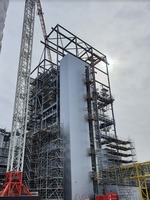- The biorefinery will be the third-largest crude tall oil (CTO) facility globally.
- Completion is expected in 2022 with an annual capacity of 200,000 tons.
- The plant will produce renewable diesel, rosin, sterol pitch, and turpentine.
- The project aims to reduce carbon dioxide emissions by 400,000 tons annually.

Project Overview
Fintoil, in collaboration with Neste Engineering Solutions, has chosen Emerson’s automation software and technologies to enhance the operational performance of its biorefinery in Hamina-Kotka, Finland. The facility will be the third-largest crude tall oil (CTO) biorefinery globally, producing advanced biofuel and biochemical feedstocks to reduce emissions and dependency on fossil fuels.
Sustainable Production
The biorefinery will process CTO, a by-product of wood pulping, to create renewable diesel, rosin, sterol pitch, and turpentine for use in various industries. These products have a carbon footprint up to 90% smaller than their fossil-based counterparts. The facility will utilize Neste Engineering Solutions’ NEXPINUS™ technology, which consumes 40% less energy than conventional tall oil refineries.
Technological Implementation
Emerson will apply its Project Certainty methodology to minimize project risk and ensure adherence to schedule and budget. This includes digitalizing project execution and remote testing of equipment. Emerson will also provide consultancy services to implement cybersecurity best practices, enhancing plant security performance.
Operational Efficiency
Fintoil and Neste Engineering Solutions will implement Emerson’s DeltaV™ distributed control system, DeltaV safety instrumented system, and DeltaV Live operator interface software. These technologies will enable efficient production, greater visibility of operational performance, and improved plant and worker safety. Advanced measurement technologies and diagnostics from Emerson’s asset management software will enhance equipment reliability and performance, contributing to greater plant availability and lower ownership costs.
Environmental Impact
The facility is expected to be completed in 2022, with an annual capacity of 200,000 tons. This will result in a 400,000-ton reduction in carbon dioxide emissions, approximately 1% of Finland’s total emissions.

